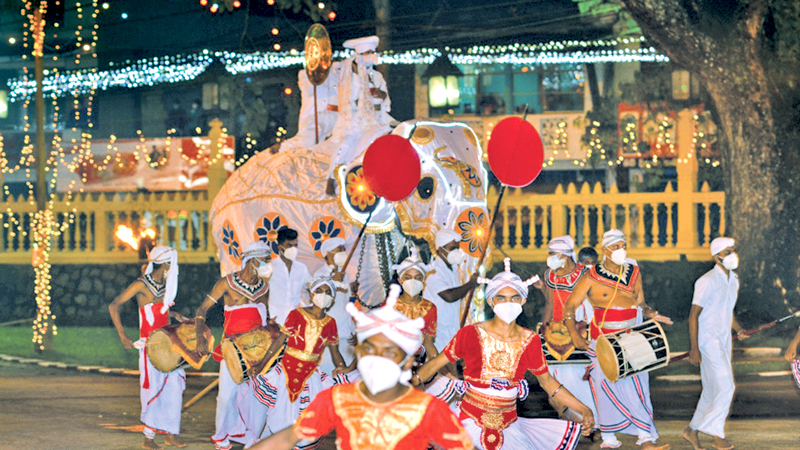The annual Esala Perahera of the Rathnapura Maha Saman Devalaya concluded on the Binara Full Moon Poya Day (September 20), after several spectacular nights of parading the streets of the famed Gem City.
 This marked the 796th Esala Festival of the Sabaragamuwa Maha Saman Devalaya, though the public was not permitted to witness the Perahera due to prevailing Covid restrictions and curfew. According to historical sources, the Sabaragamuwa Devalaya was built about 800 years ago. That was during the reign of King Parakramabahu II. According to chronicles, Chief Minister Arya Kamadeva who was in the ministerial retinue of King Parakramabahu II took the initiative to build this sacred place.
This marked the 796th Esala Festival of the Sabaragamuwa Maha Saman Devalaya, though the public was not permitted to witness the Perahera due to prevailing Covid restrictions and curfew. According to historical sources, the Sabaragamuwa Devalaya was built about 800 years ago. That was during the reign of King Parakramabahu II. According to chronicles, Chief Minister Arya Kamadeva who was in the ministerial retinue of King Parakramabahu II took the initiative to build this sacred place.
The Esala Festival is a great religious festival held in our country amidst ancient customs and traditions. There are three main Esala Peraheras in the country – Kandy (Sri Dalada Maligawa), Kataragama (Ruhunu Kataragama Devalaya) and Rathnapura (Maha Saman Devalaya).
King Parakramabahu II has entrusted this Minister with the task of strengthening the State Treasury through gem mining in Sabaragamuwa. Accordingly, Minister Arya Kamadeva arrived in Sabaragamuwa. The first thing he did was to make a vow to God Saman on behalf of the King. According to ‘Saman Siritha’, he promised to build a three-storeyed Devalaya if he was given a precious gem. The gem mining programme was very successful. King Parakramabahu II was very happy to hear this. Then he fulfilled his vow to God Saman. The statue of God Saman, brought by Minister Arya Kamadeva from Ganga Siripura to Siripa Padma, was later brought to the Saman Devalaya by the King himself.
A long description of the Saman Devalaya after the Dambadeniya period is given in the ‘Saman Devalaya’ inscription of Parakumba VI. During the reign of King Parakumba VI, several positions such as Nayake, Basnayake, Attanayake, Mudannayake and Vannathu have been created for the protection of the Devalaya. These positions have been handed down from generation to generation and are still the same today.
The Esala Perahera at the Rathnapura Maha Saman Devalaya begins with the planting of Kap. The Esala event at the Maha Saman Devalaya has three processions. Accordingly, the Kumbal Perahera, the Devala Perahera and finally the Maha Perahera are held. The Maha Perahera is one of the most spectacular cultural pageants in South Asia.
It features Upcountry, Low country and Sabaragamuwa dances, (it is the only Perahera in the country to feature all three dance forms), elephants and the Mahababa Kolam. A special feature of this procession is the arrival of the Sacred Tooth Relic which is placed in the silver casket and carried by the ‘Wasana’ elephant.
This year’s procession commenced with an all-night Pirith chanting ceremony on September 6. After planting the Kap on September 8, the Kumbal Perahera was conducted on September 12. The Maha Perahera paraded the streets from September 16 to 20 and the festival ended with the water-cutting ceremony yesterday.
The Associated Newspapers of Ceylon Limited was the print media sponsor of this year’s Esala Perahera of the Rathnapura Maha Saman Devalaya.
(Picture supplement coordinated by Wimal Karunathilake)
(Pictures by S. Rajadurai - Ratnapura Special Corr.)



Add new comment